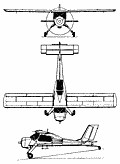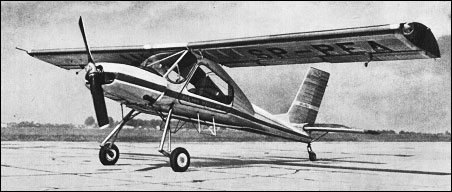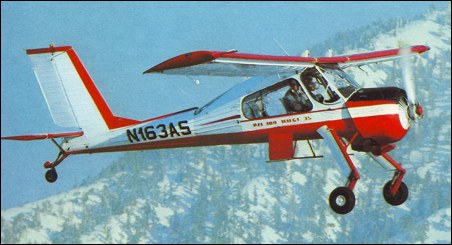|
| Designed as a successor to the Polish-built Yak-12 and the P.Z.L. 101 developed from it, the original P.Z.L. 104 Wilga (thrush) prototype, powered by a 134kW Narkiewicz WN-6 flat-six engine, was flown for the first time on 24 April 1962. A cantilever high-wing monoplane with fixed tailwheel landing gear and an enclosed cabin, it was followed by prototypes of the Wilga 2P and Wilga CP, powered by the 138kW Narkiewicz WN-6RB2 and 168kW Continental O-470-13A or O-470-L flat-six engines respectively. Intended as a general-purpose aircraft, the P.Z.L. 104 was offered initially in versions equipped for use as a four-seat passenger-carrying or liaison aircraft; for club flying, glider towing or parachuting; for agricultural use with a 500-litre hopper for dust or liquid application; and as an air ambulance carrying pilot, doctor, two stretcher patients and medical equipment. Following construction of a number of prototypes, the type entered production initially as the Wilga 3A club aircraft and the Wilga 3S air ambulance. In 1967 the design was revised to give better cabin accommodation and with improved landing gear, pro-duction beginning in 1968 of the Wilga 35 which, powered by a 194kW Ivchenko AI-14R engine, had flown for the first time on 28 July 1967, and of the Wilga 32 with a 172kW Continental O-470-K flown on 12 September 1967. This last version was built under licence in Indonesia as the Lipnur Gelatik 32 (rice bird) with a Continental O-470-R engine of similar output.
Developments of the Wilga 35 have included the Wilga 35A intended for aero-club use; the Wilga 35H floatplane fitted with Airtech (Canada) LAP-3000 floats; the multi-purpose Wilga 35M fitted with a 260kW M-14P radial engine, flown in prototype form in 1990; the Wilga 35P tourer or air-taxi version; and the Wilga 35R agricultural variant. A version generally similar to the Wilga 35, but meeting US FAR Part 23 requirements, is designated the Wilga 80. The first of these flew on 30 May 1979, and is available in three versions, the 80A, for aero-club use, the 80H floatplane, and as the 80R for agricultural use. A more radical redesign, originally identified as the Wilga 88, has become the P.Z.L. 105 Flamingo. The Wilga 35 and 80 remain
in production in 1993, by which time P.Z.L. had sold around 900 variants to countries around the world.
 | A three-view drawing (758 x 1034) |
| MODEL | PZL 104 Wilga 35A |
| ENGINE | 1 x Ivchenko AI-14RA radial piston engine, 194kW |
| WEIGHTS |
| Take-off weight | 1300 kg | 2866 lb |
| Loaded weight | 900 kg | 1984 lb |
| DIMENSIONS |
| Wingspan | 11.12 m | 37 ft 6 in |
| Length | 8.1 m | 27 ft 7 in |
| Height | 2.96 m | 10 ft 9 in |
| Wing area | 15.5 m2 | 166.84 sq ft |
| PERFORMANCE |
| Max. speed | 195 km/h | 121 mph |
| Ceiling | 4040 m | 13250 ft |
| Range | 670 km | 416 miles |
| Allan K, e-mail, 01.04.2011 04:01 I soloed on a Wilga about 30 years ago. I recall that the radial engine used compressed air to start and there was a round container that held that compressed air. So the guage was probably showing how many atmospheres of air left in the cylinder. reply | | tjipto, e-mail, 22.10.2010 18:14 indonesian build under licence , called GELATIK .
it's still used id PZL - 104. reply | | BobC, e-mail, 10.10.2010 01:22 A question. There is an instrument on the floorboard adjacent to the door for the passenger seat. It appears to be an air pressure gauge, circular in design. The part number appears to be MA-80 and there are Russian letters KGS in the center of the dial. Anyone know what this is specifically? Please email me !!! reply |
| jarecki, e-mail, 21.03.2008 15:03 Translation name of this plane is incorrect. Wilga - eng. Golden oriol. Thrush (pl. - Drozd) is completely different species of bird reply |
|
Do you have any comments?
|
| 
COMPANY
PROFILE
All the World's Rotorcraft
|









20
reply